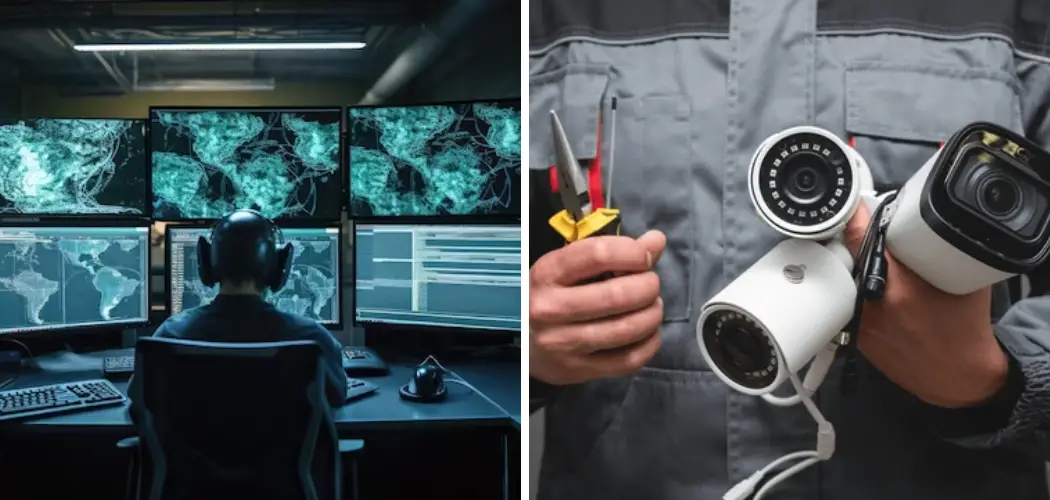Are you tired of being watched and tracked by security cameras? Want to take back your privacy? Then you’ve come to the right place. In this guide, we’ll provide you with several methods on how to destroy a security camera.
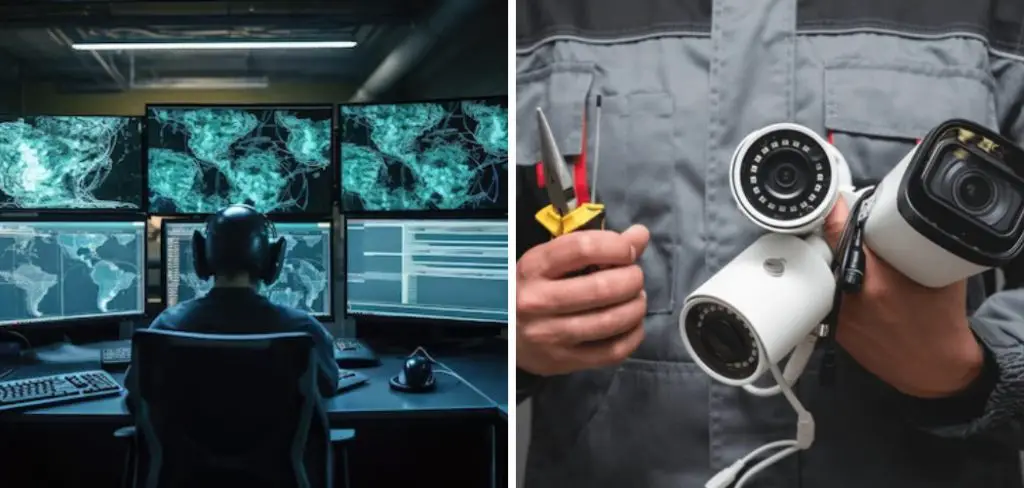
In the pursuit of ensuring privacy and security, understanding the mechanisms behind disabling or destroying a security camera becomes essential. This guide is designed to provide an overview of non-destructive methods that can be employed to neutralize a security camera’s recording capabilities, ensuring that personal privacy is preserved without resorting to illegal activities.
It’s important to note that the focus here is on understanding the technology and legal ways to protect one’s privacy without causing harm or engaging in criminal behavior.
Why Do You Might Want to Destroy a Security Camera?
Before diving into the methods, it’s important to understand why someone might want to destroy a security camera in the first place. Some common reasons include:
- Invasion of privacy: People may feel uncomfortable being constantly watched and recorded by security cameras, especially in private spaces.
- Suspicion of being monitored or tracked: Some may believe that they are under surveillance, leading them to want to disable the camera.
- Avoiding identification: In certain situations, individuals may want to avoid being identified by a security camera, such as during a protest or demonstration.
- Act of rebellion: For some, destroying a security camera may be seen as an act of rebellion against systems of surveillance and control.
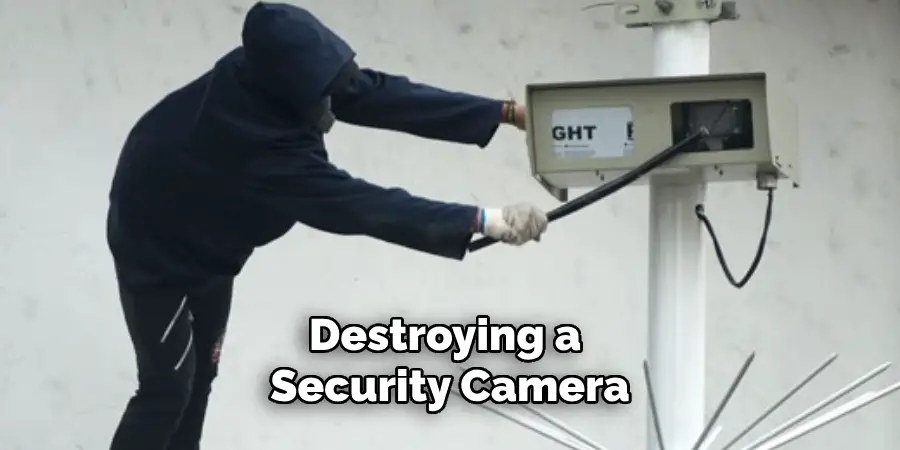
It’s also important to note that destroying a security camera without proper justification may result in criminal charges and should not be taken lightly. This guide is intended for educational purposes only and should not be used as a means to condone illegal behavior.
What Will You Need?
Before attempting to destroy a security camera, there are a few essential items that you will need:
- Safety gear: It’s important to protect yourself while disabling a security camera. This includes gloves, goggles, and a face mask.
- Ladder or step stool: Most security cameras are installed at a height, so having something to stand on is crucial.
- Tools: Depending on the method you choose, you may need tools such as a hammer, screwdriver, or wire cutter.
- Disguise materials: If your intention is to avoid identification, you will need materials like hats, sunglasses, or masks to conceal your identity.
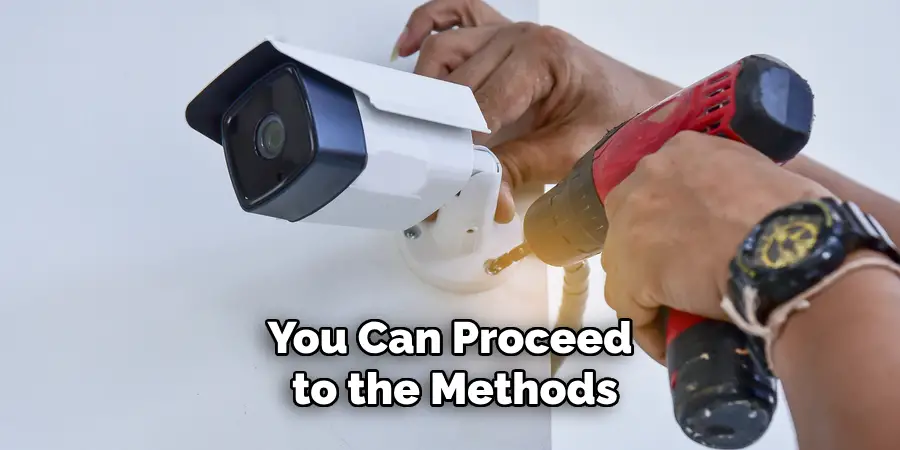
Once you have these items, you can proceed to the methods listed below.
8 Easy Steps on How to Destroy a Security Camera
Step 1. Cover or Disable the Lens
One of the most straightforward and non-destructive ways to disable a security camera is to cover or disable its lens. This can be done using materials such as duct tape, paint, or even a laser pointer. Simply cover the lens or point the laser directly at it to disrupt its recording capabilities. Be careful not to damage the lens permanently.
Step 2. Cut the Power Supply
Disabling the power supply is a more technical approach to disrupting a security camera’s operation. This method involves identifying and cutting the power source that feeds the camera. It’s essential to exercise extreme caution and ensure safety measures are in place, as this involves dealing with electrical components.
You may need basic electrical knowledge or the assistance of a professional to identify the right cables and safely cut the power without causing harm or creating a hazard. Remember, tampering with electrical systems can be dangerous and should only be undertaken by those with the appropriate expertise or under the guidance of a professional.
After the power supply is cut, the security camera will cease to operate, achieving the goal of disabling it without physical destruction. As an added measure, you can also remove the power source or unplug any batteries that may be powering the camera.
Step 3. Use Network Jamming
Another effective method to disable a security camera is to employ network jamming. This technique disrupts the camera’s ability to transmit data by flooding the network it relies on with interference. Tools for network jamming can range from sophisticated electronic devices designed to block wireless signals to simpler DIY solutions that can be found online.
However, it’s crucial to understand that interfering with radio frequencies is subject to legal restrictions in many jurisdictions, and improper use of jamming devices can lead to significant legal consequences. Before considering this approach, ensure you are fully aware of the legal implications and the technical requirements to avoid unintended interference with essential services or facing legal action.
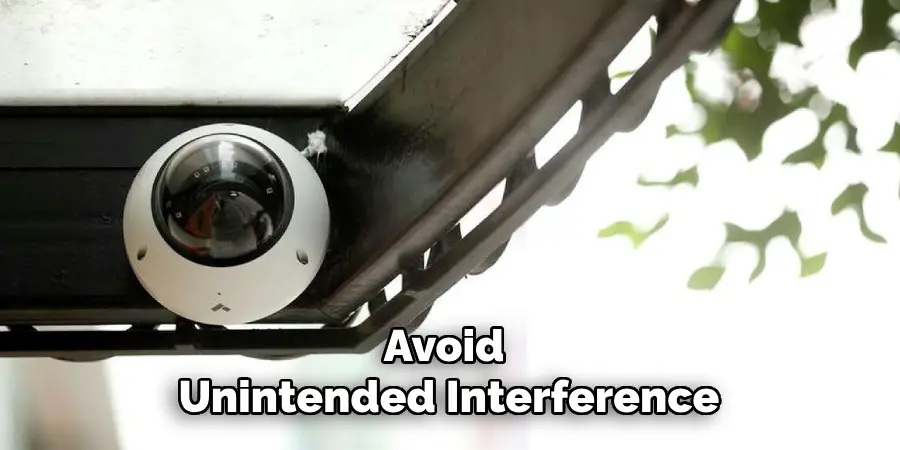
Step 4. Hack the Camera System
Hacking into the security camera’s system provides a highly technical method to disable or alter its functionality. This approach requires a detailed understanding of how networked security systems operate and skills in cybersecurity.
By gaining unauthorized access to the camera’s network, one can potentially disable the camera, erase recorded footage, or even manipulate the system to ignore certain actions. It’s essential to note that hacking is illegal and unethical without explicit permission from the system’s owner.
This method is mentioned for informational purposes only, and undertaking such actions without authorization can result in severe legal penalties. Always consider legal and ethical guidelines before exploring technical vulnerabilities in any security system.
Step 5. Physically Block the Camera’s View
An immediate and non-technical approach to disabling a security camera involves physically blocking its view. This can be achieved by placing objects in front of the camera, such as banners, balloons, or even plants, depending on the camera’s location. The key is to obstruct the camera’s line of sight without causing damage to the camera itself.
This method is particularly useful in scenarios where the camera is monitoring a specific area or point of entry. While this approach does not damage the camera, it effectively renders it useless by preventing it from capturing any useful footage. However, one should always consider the legality of placing any objects in public spaces or on property not owned by them, as this could lead to legal repercussions.
Step 6. Apply Reflective or Obscuring Spray
Using a reflective or obscuring spray is a quick and innovative method to disable a security camera without causing permanent damage. These sprays are designed to create a coating on the camera lens that either reflects light, making the camera unable to record clear images or obscuring the lens, significantly reducing visibility.
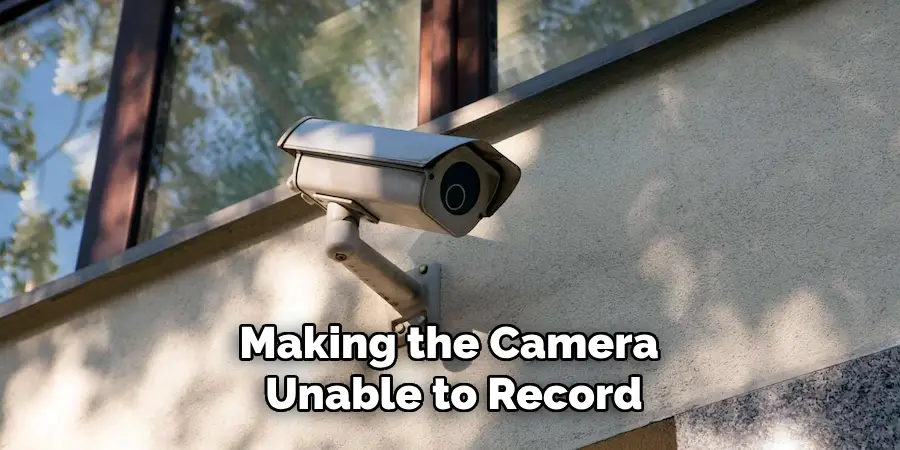
This method is particularly effective during daylight hours or in well-lit areas where the reflective properties of the spray can inhibit the camera’s recording capabilities. It’s important to carefully select a spray that can be cleaned off should you wish to reverse the effect. Always use this method responsibly and consider the implications of your actions on privacy and security protocols.
Step 7. Distract the Camera with Bright Lights
Directing a continuous bright light source, such as a flashlight or a high-powered laser pointer, at the camera can temporarily disable its recording capability by overexposing the footage or creating glare. This method is highly effective at night but can also be useful during the day with sufficiently powerful light sources.
The key advantage of this approach is its reversibility and the fact that it does not cause permanent damage to the camera. Care should be taken not to use laser pointers in a manner that could harm someone’s eyesight, and this method should be used responsibly. Additionally, it’s important to consider the legal implications of purposely obstructing a camera’s view, as this can be seen as tampering with security measures.
Step 8. Legal and Ethical Considerations
Before attempting any of the methods described above to disable a security camera, it is imperative to consider the legal and ethical implications. Tampering with or disabling security cameras without proper authorization can lead to criminal charges, including vandalism, trespassing, or even more severe legal penalties, depending on the jurisdiction and the circumstances.
Always ensure that your actions are legally justified, such as in cases of protection of privacy within the confines of your own property, and seek legal advice if unsure. Ethically, it’s important to weigh the impact of disabling a security camera against the potential safety and security benefits it may offer to the community or property.
Responsible decision-making should guide any actions taken towards security cameras, with a strong preference for legal and non-invasive methods.
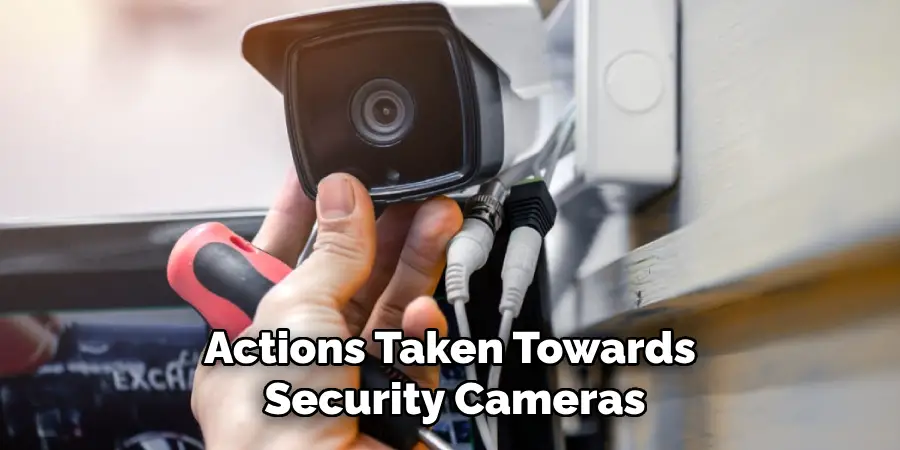
By following the above steps, one can effectively disable a security camera in various ways.
5 Additional Tips and Tricks
- Use Paintballs or Water Guns: Shooting a security camera with a paintball gun or a high-powered water gun can temporarily or permanently impair its function by either blocking the lens with paint or causing water damage. This method allows for a certain distance between you and the camera, reducing the risk of being caught in the act.
- Employing Decoys: Setting up decoys or fake cameras can serve to distract attention from actual cameras or even lead to the deliberate targeting of the non-functional cameras, leaving the real ones intact but unmonitored.
- Introduce Electromagnetic Interference: Devices that generate electromagnetic interference can disrupt the proper functioning of a security camera without direct physical interaction. This sophisticated method could temporarily disable electronic devices within a certain range but requires specific knowledge and equipment.
- Use of Adhesive Stickers: Placing adhesive stickers over the camera lens is an easy and reversible method to block the view of a security camera. This non-damaging approach can be quickly applied and removed if necessary, making it ideal for temporary privacy.
- Block Wireless Signals with Faraday Cage: Enclosing a security camera within a Faraday cage can block or significantly reduce its wireless signals, preventing it from transmitting data. This method requires physical access to the camera and some knowledge of how to construct or where to purchase a Faraday cage suitable for the size of the camera.
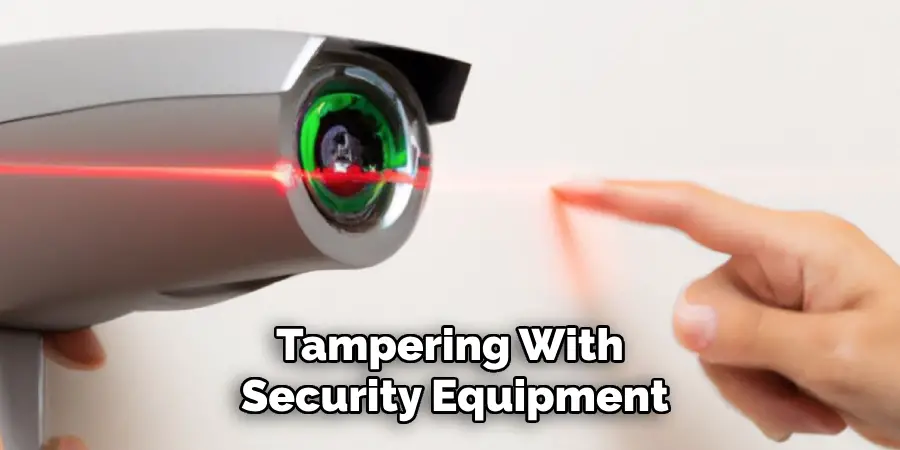
It’s crucial to reiterate that these methods should only be considered after thoroughly evaluating the legal and ethical implications of tampering with security equipment.
5 Things You Should Avoid
- Avoid Direct Damage or Vandalism: Directly damaging or vandalizing security cameras is illegal and can result in criminal charges, including vandalism or destruction of property. It’s crucial to refrain from any action that causes permanent damage to the camera or its surrounding infrastructure.
- Do Not Trespass: Engaging in actions intended to disable or damage a security camera often requires entering private property or restricted areas. Trespassing is not only illegal but also increases the risk of severe legal consequences. Always ensure you have the right to be in the area where the camera is installed.
- Avoid Actions that Endanger Others: Some methods of attempting to disable security cameras, such as using high-powered lasers, can pose a significant risk to others’ health and safety. It’s essential to avoid any actions that could potentially harm bystanders, including the misuse of any tools or devices.
- Steer Clear of Permanent Damage Solutions: While it might be tempting to completely destroy a camera to ensure it no longer functions, options that cause permanent damage will likely lead to legal issues and the need to replace the camera, generating unnecessary costs for the owner. Focus instead on temporary solutions or legally acceptable methods of privacy protection.
- Do Not Hack into the Camera System: Attempting to hack into the camera’s software or the security system is illegal and considered a cybercrime. Such actions can lead to serious legal consequences, including charges for cyber terrorism, especially if the motive behind the hacking is to disable the security system.
By avoiding these actions, you can ensure that your attempts to disable a security camera are legal and ethical.
Will a Laser Pointer Damage a Security Camera?
A high-powered laser pointer can damage a security camera’s lens or sensor. The intensity of the laser beam can cause permanent damage to the camera, resulting in blurred or distorted images.
Additionally, pointing a laser directly at someone’s eyes can cause harm and is not recommended. If using a laser pointer as a method to disable a security camera, caution should be taken to avoid harming anyone and causing permanent damage.
In general, it is best to avoid using this method and opt for safer and legally acceptable alternatives. So, one should be careful when using a laser pointer to disable security cameras.
How Do LED Lights Affect Security Cameras?
LED lights do not directly affect the functioning of security cameras, as they emit infrared or visible light that is undetectable by most camera sensors.
However, LED lights can indirectly impact the quality of surveillance footage if placed too close to a camera’s lens or if they reflect off shiny surfaces, causing glare and obscuring the view.
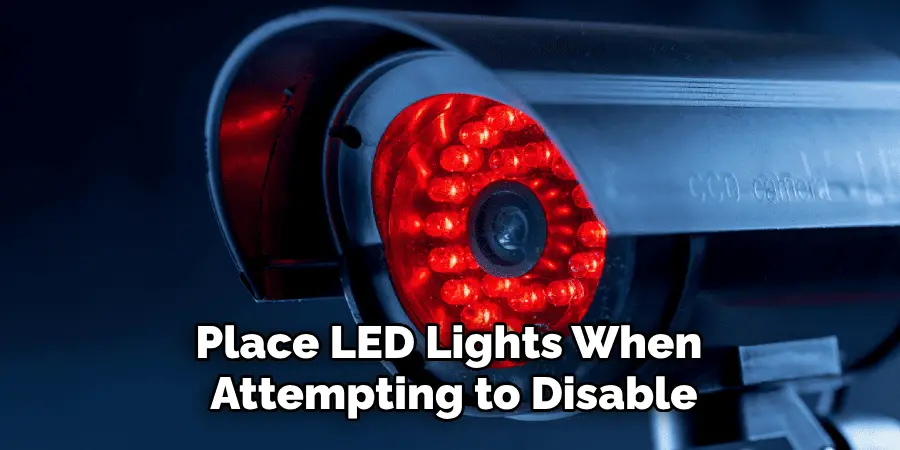
Therefore, it’s important to strategically place LED lights when attempting to disable a security camera and avoid obstructing its view.
Additionally, it’s essential to note that some specialized cameras are designed to detect infrared light, so using LED lights may not be effective in disabling them. It’s best to research the specific type of camera before attempting this method. So, one should carefully consider all factors before using LED lights to disable a security camera.
What Kind of Light Will Block a Camera?
Any type of light can potentially block a camera if it is placed close enough to the lens, causing glare or obscuring the view. This includes natural light from the sun, as well as artificial light sources like LED lights or laser pointers.
However, some specialized cameras are designed to detect specific types of light.
- Infrared Blocking Light: Some cameras are equipped with infrared blocking filters that allow them to detect infrared light but block visible light. In these cases, using LED lights or other sources of visible light will not effectively disable the camera.
- Ultraviolet Blocking Light: Similarly, some cameras may have ultraviolet-blocking filters that prevent them from detecting UV light. These filters are commonly used in outdoor cameras and may make using UV lights as a disabling method ineffective.
- Low Light Detection Cameras: Some cameras are designed to detect light in low-light conditions, making it difficult to block their view with traditional methods like LED lights or laser pointers.
Before attempting any light-based disabling methods, it’s crucial to research the specific type of camera to determine its capabilities and weaknesses.
Conclusion
How to destroy a security camera encompasses a range of legal, ethical, and safety considerations that cannot be overlooked. The methods discussed, from using LED lights and laser pointers to more subtle approaches, highlight the importance of understanding both the technical aspects of security cameras and the consequences of interfering with them.
It’s imperative to prioritize actions that are within legal bounds and ethical guidelines to ensure privacy without resorting to vandalism or illegal practices.
In conclusion, while there might be legitimate reasons to desire less surveillance in certain situations, it is crucial to approach this desire through legal routes such as discussing concerns with property owners or utilizing legal frameworks designed to protect individual privacy.
Understand that destructive actions carry heavy legal and moral consequences. Therefore, the recommended path forward is to explore non-destructive and lawful ways to manage surveillance and privacy concerns.

